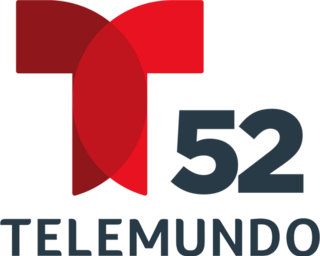
Television is one of the major mass media outlets in the United States. As of 2011, household ownership of television sets in the country is 96.7%, with approximately 114,200,000 American households owning at least one television set as of August 2013. The majority of households have more than one set. The peak ownership percentage of households with at least one television set occurred during the 1996–97 season, with 98.4% ownership. In 1948, 1 percent of U.S. households owned at least one television while 75 percent did by 1955, and by 1992, 60 percent of all U.S. households received cable television subscriptions.
Pay television, also known as subscription television, premium television or, when referring to an individual service, a premium channel, refers to subscription-based television services, usually provided by multichannel television providers, but also increasingly via digital terrestrial, and streaming television. In the United States, subscription television began in the late 1970s and early 1980s in the form of encrypted analog over-the-air broadcast television which could be decrypted with special equipment. The concept rapidly expanded through the multi-channel transition and into the post-network era. Other parts of the world beyond the United States, such as France and Latin America have also offered encrypted analog terrestrial signals available for subscription.
WFTY-DT is a television station licensed to Smithtown, New York, United States, serving Long Island as an affiliate of the True Crime Network. It is owned by TelevisaUnivision alongside Newark, New Jersey–licensed UniMás co-flagship WFUT-DT, and Paterson, New Jersey–licensed Univision co-flagship WXTV-DT, which WFTY simulcasts on its respective second and third digital subchannels. The stations share studios on Frank W. Burr Boulevard in Teaneck, New Jersey, while WFTY-DT's transmitter is located in Middle Island, New York.

WPSG is a television station in Philadelphia, Pennsylvania, United States, affiliated with The CW. It is owned by the CBS News and Stations group alongside CBS station KYW-TV. Both stations share studios on Hamilton Street north of Center City Philadelphia, while WPSG's transmitter is located in the city's Roxborough section.
WUVP-DT is a television station licensed to Vineland, New Jersey, United States, broadcasting the Spanish-language Univision network to the Philadelphia area. It is owned and operated by TelevisaUnivision alongside Wildwood, New Jersey–licensed True Crime Network affiliate WMGM-TV and low-power, Class A UniMás station WFPA-CD. The stations share studios on North Delsea Drive in Newfield, New Jersey, north of Vineland, with additional offices in Center City, Philadelphia. Through a channel sharing agreement with MyNetworkTV affiliate WPHL-TV, WUVP-DT transmits using WPHL-TV's spectrum from a tower in the Roxborough section of Philadelphia.

WFUT-DT is a television station licensed to Newark, New Jersey, United States, serving as the UniMás outlet for the New York City area. It is one of two flagship stations of the Spanish-language network. WFUT-DT is owned and operated by TelevisaUnivision alongside Paterson, New Jersey–licensed Univision co-flagship WXTV-DT and Smithtown, New York–licensed True Crime Network affiliate WFTY-DT. The stations share studios on Frank W. Burr Boulevard in Teaneck, New Jersey; WFUT-DT and WXTV-DT share transmitter facilities at the Empire State Building in Midtown Manhattan.

KVEA is a television station licensed to Corona, California, United States, serving as the Los Angeles area outlet for the Spanish-language network Telemundo. It is owned and operated by NBCUniversal's Telemundo Station Group alongside KNBC. Both stations share studios at the Brokaw News Center in the northwest corner of the Universal Studios Hollywood lot off Lankershim Boulevard in Universal City, while KVEA's transmitter is located atop Mount Wilson.

KWHY-TV is a Spanish-language independent television station in Los Angeles, California, United States. It is owned by Meruelo Broadcasting alongside Garden Grove–licensed KBEH ; the two stations share RF channel 4 under a channel sharing agreement. KWHY and KBEH share studios on West Pico Boulevard in the Mid-City section of Los Angeles and transmitter facilities atop Mount Wilson.

PRISM was an American regional premium cable television channel in the Philadelphia metropolitan area. Launched in September 1976, PRISM was primarily distributed through area cable systems, although it was also available through a scrambled over-the-air signal on WWSG-TV from 1983 to 1985.

Super TV was an American subscription television service operating in the Washington, D.C., and Baltimore metropolitan areas. that was owned by Subscription Television of Greater Washington, Inc. It was an early form of subscription television that was offered to prospective subscribers as either a standalone service to those that did not have access to cable television-originated premium services, or as an additional viewing alternative thereto.

Home Box Office (HBO) is an American pay television network, which is the flagship property of namesake parent-subsidiary Home Box Office, Inc., itself a unit owned by Warner Bros. Discovery. The overall Home Box Office business unit is based at Warner Bros. Discovery's corporate headquarters inside 30 Hudson Yards in Manhattan's West Side district. Programming featured on the network consists primarily of theatrically released motion pictures and original television programs as well as made-for-cable movies, documentaries, occasional comedy, and concert specials, and periodic interstitial programs.

ON TV was an American subscription television (STV) service that operated in eight markets between 1977 and 1985. Originally established by National Subscription Television, a joint venture of Oak Industries and Chartwell Communications, ON TV was part of a new breed of STV operations that broadcast premium programming—including movies, sporting events, and concerts—over an encrypted signal on a UHF television station and leased decoders to subscribing customers. At its peak in 1982, ON TV boasted more than 700,000 customers—more than half of them in Los Angeles, its most successful market. However, the rapidly expanding availability of cable television, coupled with a recession, caused the business to quickly lose subscribers at the same time that Oak Industries was experiencing severe financial difficulties. Between March 1983 and June 1985, all eight operations closed.
Cable television first became available in the United States in 1948. By 1989, 53 million U.S. households received cable television subscriptions, with 60 percent of all U.S. households doing so in 1992. Most cable viewers in the U.S. reside in the suburbs and tend to be middle class; cable television is less common in low income, urban, and rural areas.
W33ET-D, virtual channel 60,, is a low-power, Diya TV affiliated television station licensed to New York, New York, United States. The station is owned and operated by Major Market Broadcasting.

Spotlight was an American premium cable television network that was founded by the Times Mirror Satellite Programming Company unit of the Times Mirror Company, and owned as a joint venture with Storer Communications, Cox Cable and Tele-Communications Inc. (TCI). The channel's programming focused mainly on theatrically released motion pictures, with the only scheduling deviation being of monthly specials previewing films set to air on the channel.

SelecTV was an American subscription television service that was formed in 1976 and first began broadcasting in 1978; the service focused entirely on televising movies, and was shut down in 1989.

Spectrum was an American subscription television channel that was owned and operated by United Cable. Existing during the early 1980s, the service was available in the Chicago and Minneapolis–St. Paul metropolitan areas. It was also available in some areas of Alaska, such as Fairbanks.
Preview was an American subscription television service that launched in 1980. Like its competitors, such as ONTV and SelecTV, Preview was a scrambled UHF subscription channel requiring a special set-top box to decode the signal.

Video Entertainment Unlimited (VEU) (also referred to as VEU Subscription TV) is a defunct American subscription television service that was owned by the Golden West Subscription Television, Inc. subsidiary of Golden West Broadcasters, which operated from May 1, 1980, until September 30, 1984. VEU aired a broad mix of feature films (including mainstream Hollywood blockbusters, lesser-known mainstream films, and softcore pornography) as well as sports events and specials.
Family Broadcasting Corporation, formerly known as LeSEA Broadcasting, is an American Christian television network. Founded by Lester Sumrall in 1972, Family Broadcasting Corporation is headquartered in South Bend, Indiana, and broadcasts Christian and family programming. Peter Sumrall, son of Lester Sumrall, served as its president and chief executive officer from 2002 to 2015. His son, Drew Sumrall, now serves in the same position.











